Although every link in the supply chain is critical for fulfilling customer orders, perhaps the most important stage of all is last-mile delivery. But it’s also the most complex and expensive, accounting for up to 53% of your total shipping costs.
When you factor in the rapid growth of e-commerce retail (boosted by the pandemic), and rising customer expectations for fast and free shipping, the task of achieving seamless last-mile delivery becomes even more difficult.
Businesses must work hard to control their multiple moving parts and reduce inefficiencies that lead to spiraling costs and unhappy customers. We’re going to take you through the challenges and solutions, and show you how the right delivery partners and software (such as Brightpearl) can help.
What is Last-Mile Delivery?
Last-mile delivery is the final step of the delivery process, when a product is transported from your business to its final destination. Despite the name, it doesn’t literally mean that packages only travel for one mile—this leg of the journey could cover anything from a few blocks to 50 miles.
Before e-commerce, the final destination was typically a brick-and-mortar store where the goods would be sold. Now, when an online order arrives, you have to deliver to the customer’s doorstep, or to a collection point.
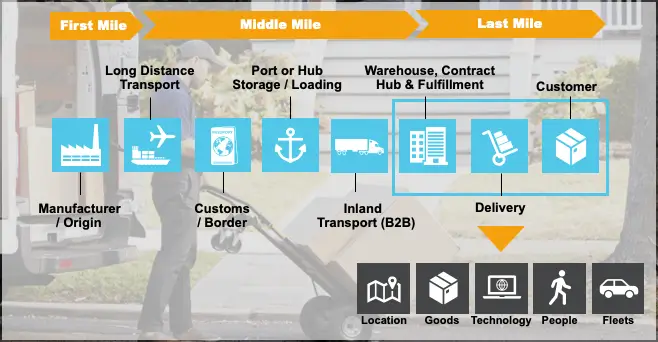
Source: merchantsfleet.com
Once an order is processed, the items are picked up from your warehouse, distribution center, or retail store. Sometimes they are taken to a separate transportation hub, from where the delivery driver collects the parcels and delivers them to the end user.
The process involves numerous orders traveling to different locations, meaning multiple stops with low drop sizes. That’s why businesses often use small parcel carriers for final-mile delivery. It’s also why you need robust last-mile logistics, to ensure orders arrive in a timely and cost-effective manner.
Last-Mile Delivery Options
There are various options for last-mile delivery, from hiring well-known carriers like FedEx, to running your own fleet. Some retailers offer deliver-from-store last-mile services, while some are turning to new technology such as drones and autonomous vehicles.
It’s important to make the right choice, as customers won’t care who brings their parcel—only that it arrives as promised.
In-House Fleets
With this option, you’re in complete control of the last-mile delivery experience. You own a fleet of vehicles, and you employ drivers who only deliver your products. It means you can oversee the whole operation, quickly handle any problems, and offer a more personalized service to customers.
However, operating an in-house fleet is expensive, from driver salaries and gas prices to vehicle maintenance and technology. You might get so overwhelmed by logistics that you pay less attention to other areas of the business. And you may not have the resources to expand the fleet as order volume grows.
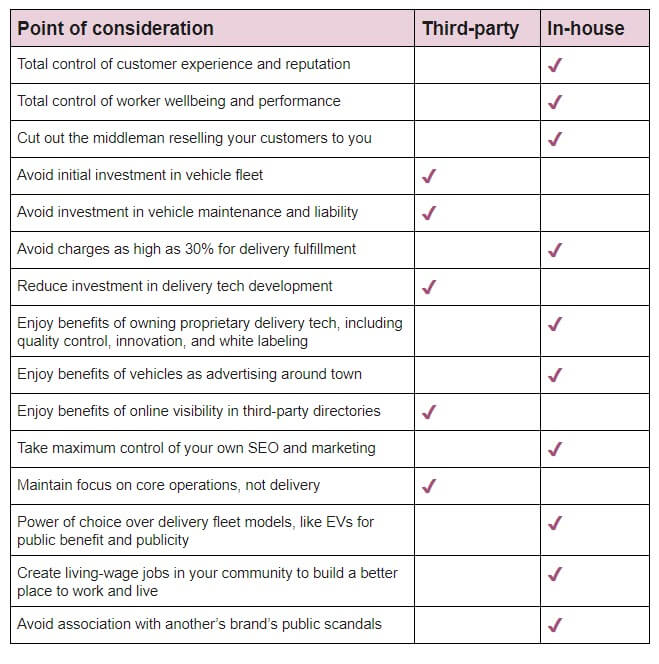
Source: moz.com
Traditional Carriers
The majority of companies use external partners for last-mile delivery, such as traditional postal services. Although you’re handing over control, you won’t have the stress and expense of managing your own fleet. You will, though, have to negotiate the best delivery rates (arranging home delivery with the USPS may be cheaper as their vehicles already visit residential addresses).
The downside is that traditional providers can’t offer much flexibility, so you have to fit in with their schedules rather than the other way around. And an inflexible infrastructure can struggle at peak times such as the holiday season.
Local Carriers
To achieve greater flexibility, you could use a local courier service. These are typically smaller operations with fewer, smaller vehicles, so it’s a good choice if your company ships low quantities of small items. Try to find a carrier that’s based near your warehouse, so you reduce travel costs and the drivers are familiar with the local area.
Remember that smaller firms may not have the capacity to scale with increased demand, so you may need to choose several delivery service providers (especially if you have multiple locations). Orchestrating various partners means more admin and a risk of inconsistency—although not if you manage them in one place with Brightpearl.
Crowdsourced
This delivery solution is growing in popularity, especially now that consumers are familiar with the crowdsourcing concept. Companies such as Amazon Flex, Uber, and Postmates post jobs on their apps, to be claimed by independent drivers who use their own transport to make deliveries.
By tapping into the gig economy, businesses can scale delivery operations to meet demand—with no upfront investment. Customers can schedule on-demand deliveries for the most convenient time, so fewer parcels need to be redelivered.
Just be aware that crowdsourced delivery is harder to control than a managed delivery system. Plus, the drivers are not usually trained couriers, so you need to be confident that they’ll handle your packages appropriately.
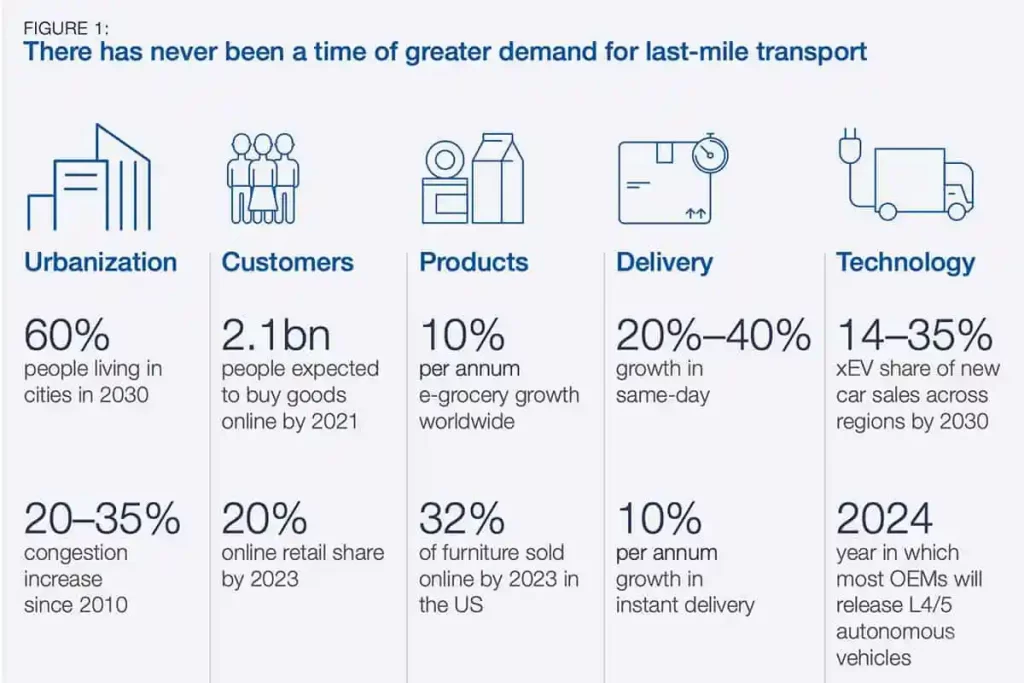
Source: theecobahn.com
Challenges in Last-Mile Delivery
Last-mile delivery comes with plenty of challenges, especially if you’re handling multiple orders. Some will be outside your company’s control, while others can be mitigated against with efficient practices.
Profit Margin
One of the biggest challenges is that customers expect premium services at a non-premium cost, which they can get from the likes of Amazon Prime. While some consumers are willing to pay extra for convenience, many companies feel they have to shoulder the cost of free shipping in order to stay competitive.
Inefficiencies in last-mile delivery can put a serious dent in your profits. For example, failure to optimize routes or to factor in peak order times, and a lack of shared information between vendors and carriers. If parcels are delayed or lost, it will cost you to reimburse the customer or send out a replacement.
Number / Frequency of Orders
As your retail business grows, supply chain logistics become more complicated—including last-mile delivery. An increase in order volume means more items to be picked and packed ready for collection, so there’s more risk of errors creeping in.
If you don’t have a robust system in place, you can easily send the wrong parcels out for delivery or give the driver the wrong address. Another problem is that with next-day delivery, it’s harder to ensure that you fully utilize vehicle capacity—you don’t have time to wait for enough orders to fill the van.
Location and Proximity
Last-mile delivery is about getting the items there as quickly and cost-effectively as possible, and you can’t achieve that if your distribution center is nowhere near your customer base. Whether you use your own fleet of vehicles or a carrier, it’ll cost more to cover a longer distance—and the parcel is more likely to encounter delays.
Many companies base their warehouses in urban areas close to a lot of customers, but urban delivery means navigating traffic and parking regulations. However, rural drop-offs have their own set of issues. It’s a good idea to partner with a third-party logistics provider (3PL) as they’ll have a wider network of distribution centers.
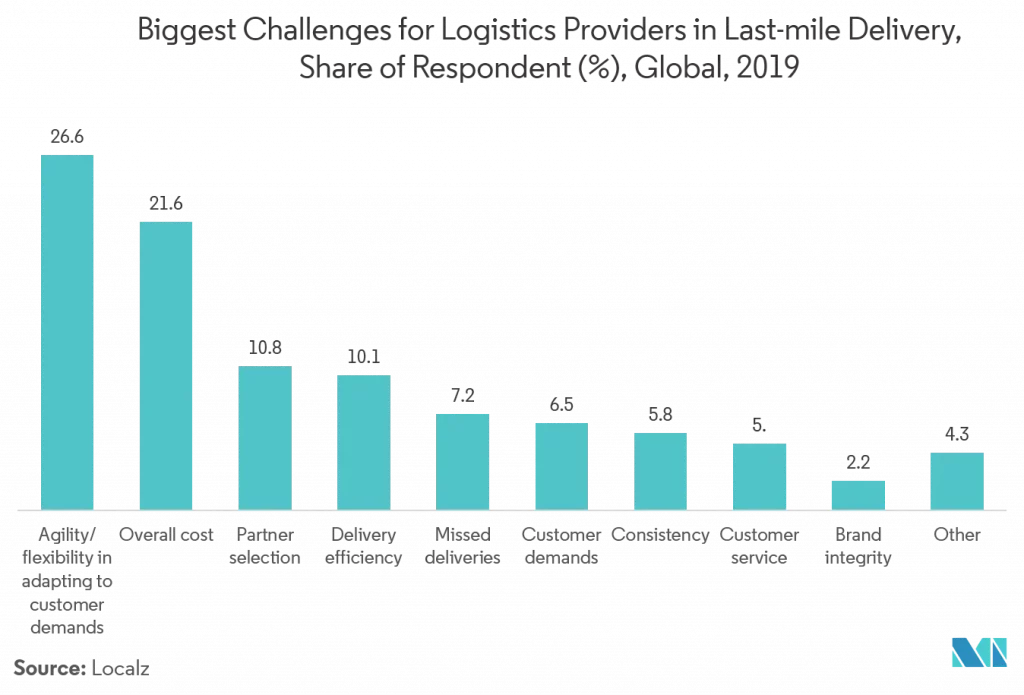
Source: mordorintelligence.com
Number of Deliveries
The more orders you take, the more often your carrier will be summoned to collect parcels and drop them at more locations. If you’re running an in-house fleet, you need to plan the routes carefully and make sure you have enough drivers. If you’re using a carrier, you can try to negotiate bulk rates for large and frequent deliveries.
Failure to optimize the route and maximize vehicle capacity leads to wasted time and unnecessary fuel consumption, which will prove costly for your business. There’s also the environmental cost to consider, especially as 67% of shoppers consider eco-friendly practices in their purchase decisions.
Poor Customer Experience
In e-commerce, last-mile delivery is usually the only time a customer interacts with a representative of your company (even if it’s a delivery driver from a hired carrier). That’s why it’s so important to get it right.
If the process is executed badly, it can lead to delays, missing parcels, mixed-up deliveries, or even damaged items due to careless handling. With 58% of customers saying they’ve stopped using a retailer after a negative delivery experience, it’s crucial that you do everything you can to keep them on side.
Solutions to the Challenges of Last-Mile Delivery
The good news is, there are a number of strategies you can implement to meet the challenges. Optimizing last-mile delivery will reduce the total cost of fulfillment and shipping, as well as ensuring your customers receive a positive experience.
Delivery Partner
If you don’t have the budget or resources for in-house delivery, or you’re struggling to handle increasing order volumes, the solution is to work with a delivery partner. This might be a traditional or local carrier, or you might choose to outsource the whole fulfillment process to a logistics company.
Either way, it’s important to find the right partner for your needs. Obviously, they should be reliable and trustworthy with a great reputation, but they should also have a base in the areas where your customers live, and be able to sync their systems with yours for full visibility.
Proof of Delivery
Proof of delivery (PoD) is a form of documentation that confirms an item has been delivered. It typically contains a signature from the recipient, a date and time stamp, and a photo of the package in the correct location. These days, PoD is electronic and integrated with a mobile app.
PoD adds greater transparency to the delivery process and helps to guard against parcels being mislaid or stolen. The ability to track items gives reassurance to companies and customers alike, and it’s also a good way of collecting customer data and feedback.
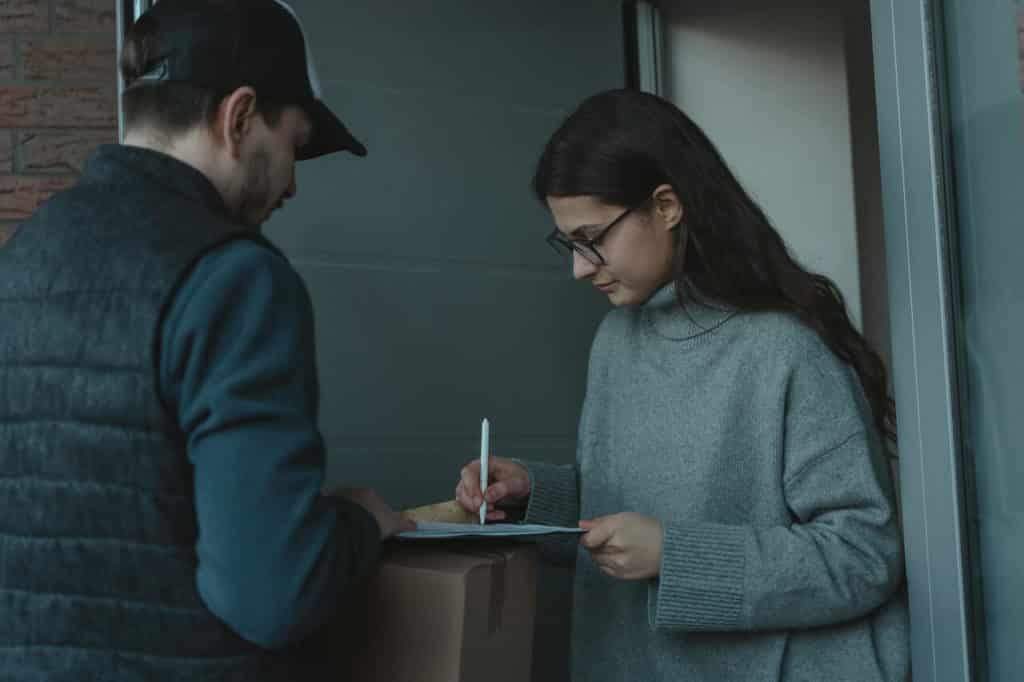
Labor Costs
Using automation in your warehouse will help you save on the cost of picking and packing by boosting productivity and reducing errors. And smart software lets computers take the strain when it comes to planning routes and tracking orders.
You can also reduce last-mile delivery costs by consolidating orders into as few shipments as possible. Another way to reduce the number of drivers required is to let customers collect their orders from parcel lockers, which means drivers only drop at one or two locations rather than multiple residences.
Reporting
The best way to ensure everything runs smoothly is to keep monitoring your last-mile delivery operations and reporting the results. Make sure all deliveries are logged and tracked, and measure metrics such as success rates, distance traveled, and feedback scores.
Regular reports will help you to identify problems and work out where you need to make changes. This also helps you plan ahead and make financial decisions—are you getting value for money from your partner? Are you incurring extra costs from damages or returns?
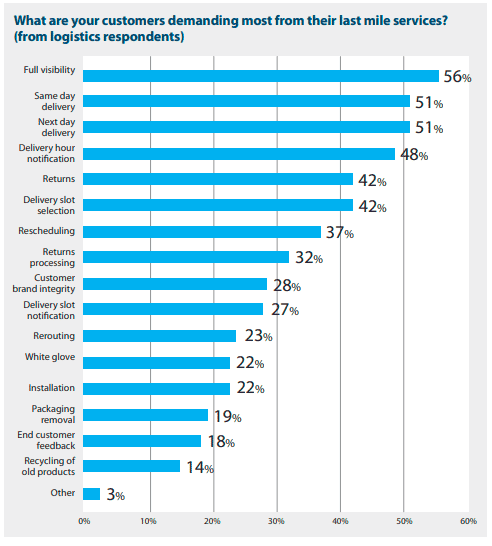
Source: getfareye.com
Customer Experience
As we mentioned before, you have to give customers a great experience if you want to retain them. Offer plenty of convenient delivery options, including collection from a store or locker, and give them the ability to track their order with updates and SMS notifications. Above all, set clear expectations and deliver on your promises.
Personalization is a good way to delight customers. You could add notes to parcels, use customized packaging, and send free gifts to reward loyalty or to make up for a problem. Encourage customers to write a review after a positive experience, to really make the most of your efforts.
2022 Trends in Last-Mile Delivery
The solutions discussed in the previous section are timeless, but it’s also important to stay up-to-date with emerging trends. Here are some popular developments for 2022:
Fast Order Fulfillment
Delivery time has been increasing in importance since e-commerce sales took off, and today’s customers expect you to offer next-day or even same-day delivery. Rapid order fulfillment depends on streamlined processes, including last-mile delivery—so you need advanced technology (like Brightpearl) to help you cope.
One way of expediting the process is to use your physical stores as mini fulfillment centers for online orders. Because they’re located near your customer base, it’s easier to achieve fast local delivery. Using your existing assets is cheaper than renting extra warehouse space.
Traceability
As well as fast delivery, customers now expect transparency when it comes to order status. They want to track packages at all times, communicate with drivers for regular updates, and receive proof of delivery.
Traceability is good for your company, too, as it avoids confusion and disputes. Set up a system where orders are digitally recorded into the carrier’s system and assigned to drivers, who will record and update the status once the parcel is delivered.
73% of supply chain professionals say they can’t currently offer real-time tracking, so this is a good way to get ahead of your competitors.
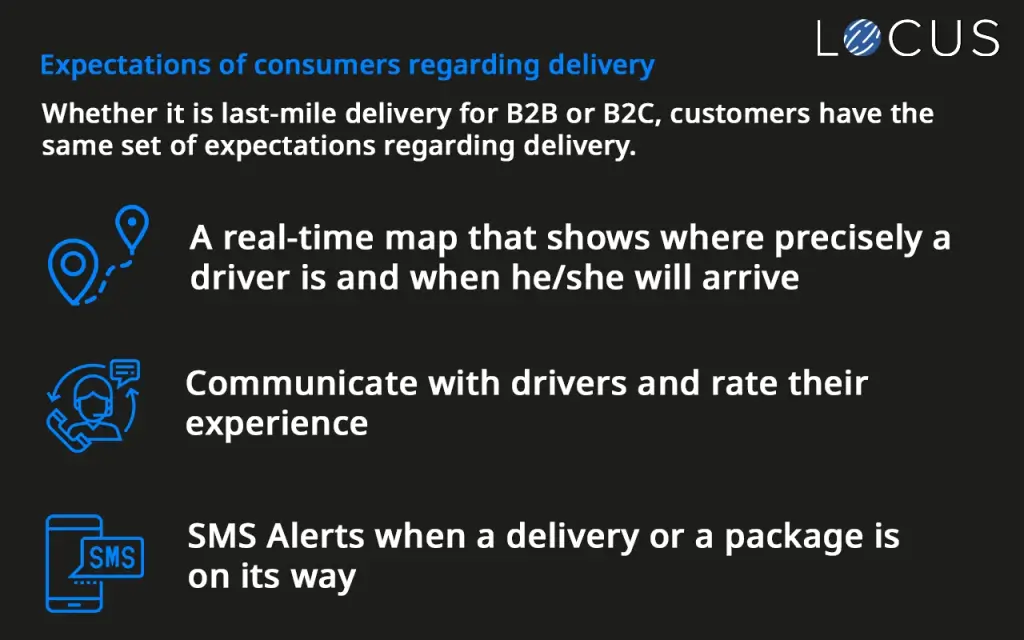
In-House Delivery
Although it can prove expensive, the in-house method is popular with companies who want to ensure accurate last-mile delivery. It allows you to control costs and the customer experience, and you can expand your delivery times as you’re not reliant on a carrier’s schedule.
To do this successfully, you’ll need your own technology solution (SaaS software such as Brightpearl is sold on a subscription basis so there’s no large upfront cost). You could also partner with other businesses in your area in order to share transportation assets.
Dropshipping
Dropshipping is popular with startups and smaller firms because it helps them cut costs on storage and fulfillment. Because the dropshipper sends orders directly to customers, you don’t need warehouse labor or delivery drivers, and you don’t need to worry about planning routes.
On the flipside, you have little control over how items are delivered, and it’s harder to negotiate good shipping rates. It’s crucial to choose a reliable partner who won’t damage your reputation. Another option is to use dropshipping for large products only, and fulfill smaller orders yourself.
Micro-Warehousing
This trend sees companies opening very small warehouses in places like shopping centers, in addition to their main distribution center. As well as providing more storage space, it enables rapid delivery to an urban area and gives customers the option to collect their packages locally.
Micro-warehousing helps smaller companies to stay competitive, although it’s best for basic, durable goods as the inventory carrying costs for high-value or customized products may be too high. With Brightpearl, you can manage multi-warehouse fulfillment with ease.
Upsells
You’ve heard of upselling in a retail context, when online and physical stores entice customers to complement their purchase with extra items. Now this concept is being used in last-mile delivery, using the same predictive intelligence technology to anticipate customers’ needs.
Delivery drivers bring along items that the customer has ordered previously, or things that their online behavior suggests they might like. They ask if the customer is interested, and process the additional order on the spot. This method is particularly applicable to food delivery.
Technology
As e-commerce sales grow and customers become more demanding, companies involved in supply chain management need more advanced technology to handle last-mile delivery. Fortunately, technology is also improving, with tools for real-time order tracking and delivery route optimization.
The digitalization of last-mile delivery processes includes automated alerts, route updates based on weather and traffic conditions, and even in-parcel sensors to track temperature. Customers may want to amend their delivery location and time, and a smart solution can accommodate changes quickly by updating workflows.
Qualities of the Right Last-Mile Delivery Partner
Each business will have its own way of organizing last-mile delivery, but there are some common qualities that all partners should possess:
Scalability
Your goal is to grow your business, so you need a partner that can scale with you as this happens, whether that’s a large courier firm or a 3PL. As you expand, you need to know that your partner is capable of handling a higher volume of orders and delivering to more locations. Some courier companies have satellite branches in strategic locations for easier access.
To ensure that last-mile delivery remains cost-effective as you scale, look for a partner which offers discounts for regular bulk deliveries, and that will reward you for your ongoing custom and loyalty by giving preferential rates and prioritizing your orders.
Service and Professionalism
It goes without saying that professionalism is key. When you outsource any step of the fulfillment process, you are putting your reputation in your partner’s hands—if they get things wrong, it reflects badly on you. They need to commit to meeting your expectations for delivery speed and accuracy.
Pick a carrier with plenty of services to choose from, as well as great customer support that’s there whenever you need it. You might want a partner who specializes in the type of products you sell, such as grocery and pharmaceutical products which require temperature control.
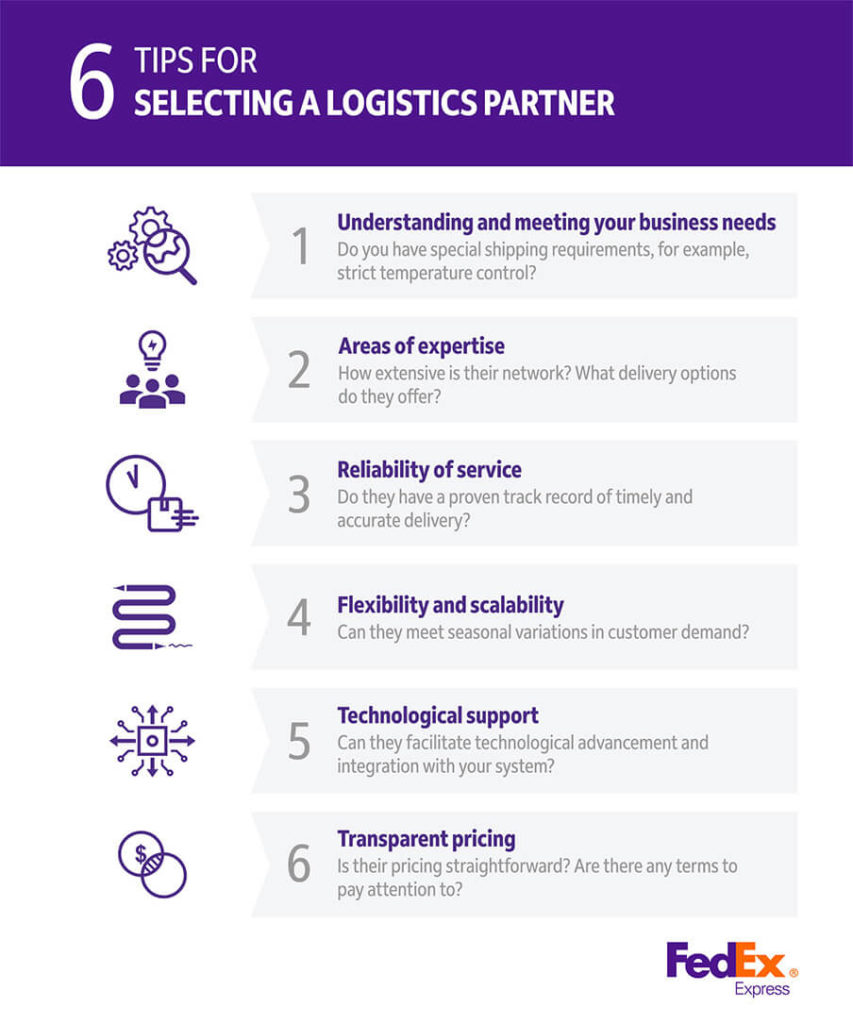
Accountability
It’s important that your chosen partner takes full responsibility for their role in last-mile delivery. They should offer a guaranteed service and comprehensive insurance, but be accountable for any mistakes rather than trying to pass the buck.
You need to know that office staff and drivers will deal politely with your customers when they interact. Ask if they carry out their own feedback and measure success rates. You should also look for transparent pricing and a commitment to sustainable practices.
Technology
Your delivery partner should have the latest technology, such as artificial intelligence and machine learning to automatically generate the most efficient routes. It’s essential that they can track vehicles in real-time, send alerts to help drivers avoid traffic congestion or road closures, and monitor vehicle capacity and fuel consumption to help you reduce costs.
It’s best if their systems can integrate with your order management and inventory management software, so that you can easily sync data, share information, and maintain visibility.
Partnership
It sounds obvious, but you and your partner need to work as a team to ensure that last-mile delivery is successful for everyone. Clear, constant communication is vital—they must be willing to share data and let you know in advance about any problems, with the expectation that you will do the same for them.
It’s worth asking if your carrier assigns a dedicated expert or team to look after your orders, so that they can get to know your business needs and provide tailored support. A smooth partnership benefits both of your firms, as well as ensuring customer satisfaction.
How can Brightpearl Help Your Last-Mile Delivery?
Choosing the right partner is only one aspect of successful last-mile delivery. You also need effective systems and processes as products move through your warehouse on their way to delivery trucks—and that’s where Brightpearl can help.
As a comprehensive retail operating system, Brightpearl ensures everything from supplier management to order fulfillment is fast and efficient. It has partnerships with all the major e-commerce platforms, shippers, and 3PLs, enabling you to manage them all in one place.
The Automation Engine helps you streamline inventory and warehouse management so that there are no delays in the last-mile delivery stage. It also reduces errors, which annoy customers and cost you money. You can create rules for the entire fulfillment process, including automatic dropshipping for specific orders.
Brightpearl’s Demand Planner enables you to make accurate forecasts, so you can order the right amount of stock and set a budget for last-mile delivery. You’ll be able to predict peak times and liaise with delivery partners, meaning no last-minute changes that could drive up costs and hamper operations.
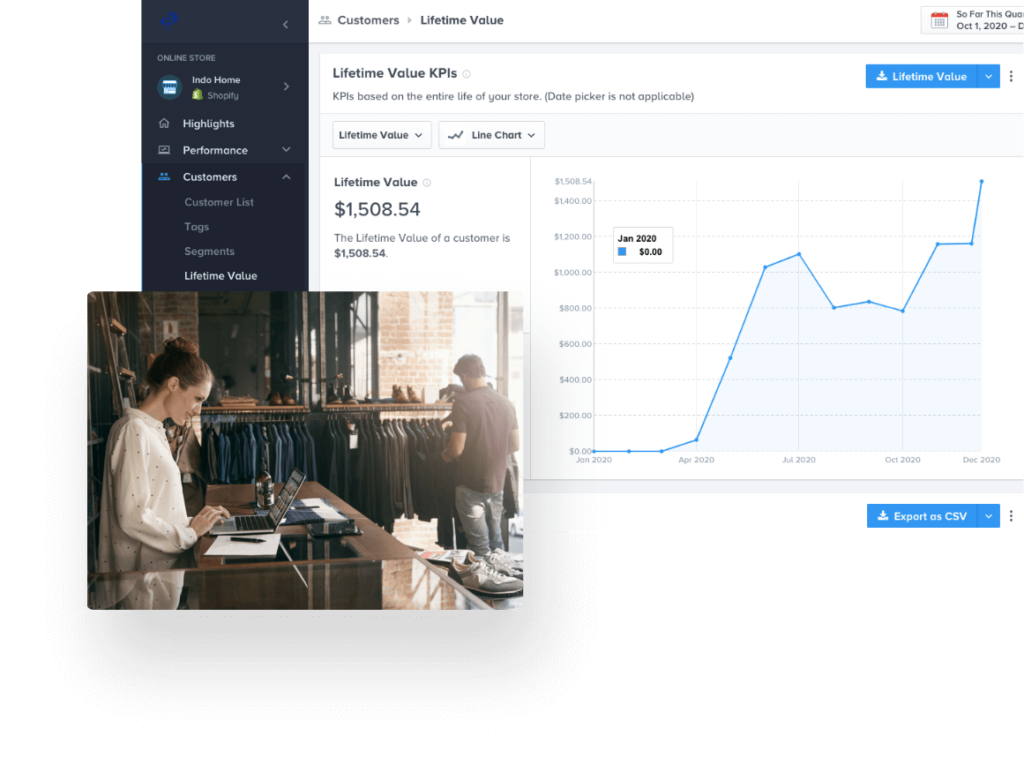
Other Benefits of Using Brightpearl
Because Brightpearl is designed for retail, you have all the features you need in one place, and you’re not paying for tools you don’t use. Here are a few of the other many advantages:
Flexibility
Customers want flexible delivery options, and Brightpearl enables that through its integrations with shipping partners and 3PLs alongside automation for dropshipping, multi-warehouse picking, partial fulfillment, and backorders. The system is built to handle complexity and high order volumes, so you can always deliver on your promises.
Visibility
Visibility is so important to the supply chain—you can’t hope to get last-mile delivery right if you’re not aware of stock levels, or you fail to order replenishments on time. In Brightpearl, all your data from sales channels, warehouses, and suppliers (and the built-in POS and CRM) is synced for real-time insights and a 360-degree overview.
Analytics
Brightpearl gives you analytics, business intelligence, and reporting capabilities, with the figures displayed in simple dashboards to help you make smart decisions. As well as optimizing stock levels and learning about customer preferences, you can monitor the success rate of deliveries and quickly address any last-mile problems.
Scalability
Brightpearl is designed to grow with your business, enabling you to expand your tech stack when required, and manage multiple partners with the help of integrations. There’s robust support, including a dedicated Customer Success Team to guide you through implementation and beyond.
Final Thoughts
As e-commerce continues to grow, the last-mile delivery market is growing right along with it. By 2024, it’s forecast to grow by $44.88 billion. The rise of omnichannel and multi-location retail makes the process more complex, while customers continue to demand fast and free delivery, traceability, and a great experience.
That’s why it’s crucial to have the right systems in place, from working with a reliable delivery partner to using the best technology. Check out Brightpearl’s website to find out how it can help you get last-mile delivery right every time.
